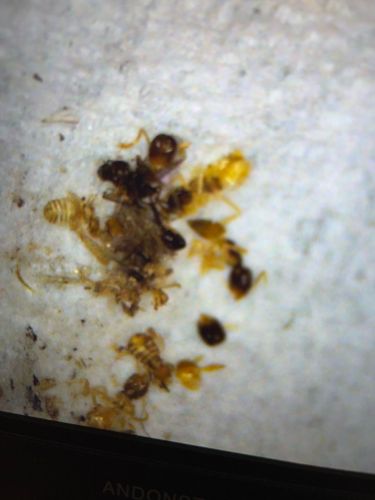Ants and Termites
Scientific Name: Ants: Varies by species (e.g., Lasius niger for black garden ant, Solenopsis invicta for fire ant). Termites: Varies by species (e.g., Coptotermes formosanus for Formosan subterranean termite, Reticulitermes flavipes for eastern subterranean termite). The exact species visible in the image cannot be determined without clearer identification.
Order & Family: Ants: Order Hymenoptera, Family Formicidae. Termites: Order Blattodea (infraorder Isoptera), various families (e.g., Rhinotermitidae, Kalotermitidae).
Size: Ants: Typically 2 mm to 25 mm depending on the species. Termites: Ranging from about 3 mm to 15 mm for workers and soldiers, with queens being much larger, up to 100 mm in some species.

Natural Habitat
Ants can be found in various habitats worldwide, including forests, grasslands, deserts, and urban areas, building nests underground, in wood, or in mounds. Termites are also widespread, typically found in tropical and subtropical regions, living in colonies within wood, soil, or elaborate mounds.
Diet & Feeding
Ants have diverse diets, some are omnivorous scavengers, while others may be predatory. Termites primarily feed on cellulose (wood, dead plants). The image suggests ants preying on or scavenging termites.
Behavior Patterns
Ants are social insects that live in structured colonies. They are known for their cooperative foraging, building complex nests, and division of labor. Termites are also social insects, forming large colonies with a caste system including workers, soldiers, and reproductives. They are detritivores, consuming dead plant material, particularly wood. The image shows ants (likely scavenger ants or competing species) preying on or scavenging near termites, possibly including termite larvae or nymphs, and maybe some termite eggs.
Risks & Benefits
Ants can be considered pests when they invade homes or gardens, contaminating food or damaging structures. Some species can sting or bite. However, ants also play important roles in ecosystems as predators, scavengers, and seed dispersers, contributing to soil aeration. Termites are significant pests as they can cause extensive damage to wooden structures, furniture, and crops. Ecologically, they are beneficial decomposers, recycling nutrients from dead wood back into the soil.
Identified on: 9/4/2025